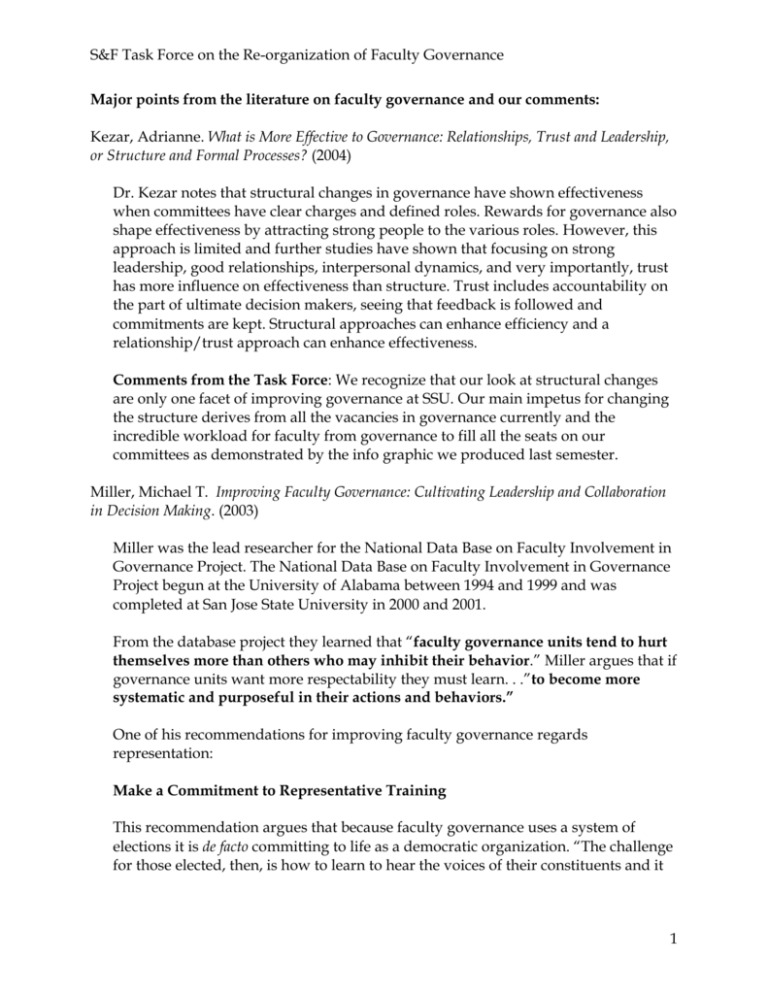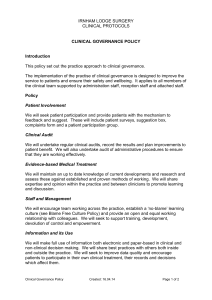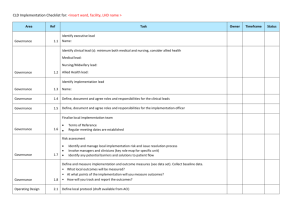S&F Task Force on the Re-organization of Faculty Governance
advertisement

S&F Task Force on the Re-organization of Faculty Governance Major points from the literature on faculty governance and our comments: Kezar, Adrianne. What is More Effective to Governance: Relationships, Trust and Leadership, or Structure and Formal Processes? (2004) Dr. Kezar notes that structural changes in governance have shown effectiveness when committees have clear charges and defined roles. Rewards for governance also shape effectiveness by attracting strong people to the various roles. However, this approach is limited and further studies have shown that focusing on strong leadership, good relationships, interpersonal dynamics, and very importantly, trust has more influence on effectiveness than structure. Trust includes accountability on the part of ultimate decision makers, seeing that feedback is followed and commitments are kept. Structural approaches can enhance efficiency and a relationship/trust approach can enhance effectiveness. Comments from the Task Force: We recognize that our look at structural changes are only one facet of improving governance at SSU. Our main impetus for changing the structure derives from all the vacancies in governance currently and the incredible workload for faculty from governance to fill all the seats on our committees as demonstrated by the info graphic we produced last semester. Miller, Michael T. Improving Faculty Governance: Cultivating Leadership and Collaboration in Decision Making. (2003) Miller was the lead researcher for the National Data Base on Faculty Involvement in Governance Project. The National Data Base on Faculty Involvement in Governance Project begun at the University of Alabama between 1994 and 1999 and was completed at San Jose State University in 2000 and 2001. From the database project they learned that “faculty governance units tend to hurt themselves more than others who may inhibit their behavior.” Miller argues that if governance units want more respectability they must learn. . .”to become more systematic and purposeful in their actions and behaviors.” One of his recommendations for improving faculty governance regards representation: Make a Commitment to Representative Training This recommendation argues that because faculty governance uses a system of elections it is de facto committing to life as a democratic organization. “The challenge for those elected, then, is how to learn to hear the voices of their constituents and it 1 S&F Task Force on the Re-organization of Faculty Governance is in this regard that faculty governance is generally less sophisticated than student governance” (emphasis ours). Here are examples collected about how student governance leaders work to hear their constituents voices: Senators meet with academic Deans and Department Chairs; Senators have an open meeting once a semester with students in their college/major; Senators keep a webpage of issues before the general student government that can impact the college/major; Senators visit an academic department every other week during a semester; Senators sit at tables in open areas of the college/department, will to talk to any student who comes by and hear their concerns; Senators make announcements at all-college/department faculty meetings; Senators visit classes and make a quick announcement about wanting feedback; Senators visit student groups affiliated with the college/department and ask for feedback or input about topics or issues to be considered; Senators distribute “interest forms” asking for ideas, topics, or issues to be considered, and the interest forms can be submitted anonymously and; Student senators meet with faculty senators to discuss issues that might be similarly discussed. “For faculty senate leadership, then, the challenge is to develop a set of habits among faculty senators and a sense of responsibility to share information and gather input about important issues.” Comments from the Task Force: Our approach to reducing the size of the Senate itself is one idea toward improving the quality of representation in the Senate. The Senate Analyst’s survey in 2008 (http://www.sonoma.edu/senate/reports/SchoolRepsReport07_08.pdf) found that most representatives on the Senate represent their departments instead of their Schools. We thought that by reducing the number of reps, faculty could more easily follow the spirit of our current by-laws which request that reps attend the department chair meetings. Additionally, one idea was to group departments together, based on the idea that people already naturally represent their department and might find it relatively easy to add a few more. We ask the Schools to consider this information when discussing representation on the Senate. Gayle, Dennis John; Twearie, Bhodndradtt; White A. Quinton, J. Governance in the Twenty-First Century University: Approaches to Effective Leadership and Strategic Management. (2003). 2 S&F Task Force on the Re-organization of Faculty Governance This is a report from the Association for the Study of Higher Education, the ERIC Clearinghouse on Higher Education and the George Washington University Graduate School of Education and Human Development. It offers “approaches to effective leadership and strategic management in the twenty-first university, using a distinctive entry point: the perceptions and attitudes of university leaders toward the institutional structures and organizational cultures within which we lead and manage our universities, together with the implications of these attitudes for the central concerns of higher education.” They discuss the national issues impacting most universities and the potential impacts on shared governance. They organize their report under the following topics: governance and teaching and learning; governance, information technology and distance education and resource allocation and governance. Shared governance includes faculty, administrators and trustees. As part of this report, they discuss a 1998 research project of a group of American Council on Education fellows that surveyed research and doctoral universities, comprehensive universities and baccalaureate colleges about the perceptions of governance shared by faculty, administrators and trustees. This 1998 research came to the following conclusions. The top four areas where all agreed that faculty rather than administrators should have primary roles were: curriculum, academic policies, tenure/promotion, and other personnel issues such as faculty recruitment and conditions of employment. 77% of baccalaureate and 80% of comprehensive institutions “assigned high rankings to the significance of teaching and learning as a focus for governance.” Most faculty leaders thought information technology should make information widely available, but this was not the general experience. Most respondents did not perceive a direct link between budgetary issues and the governance process. A large majority of faculty leaders and vice presidents indicated that organizational culture “was, in principle, a major catalyst for, or constraint on, shared governance.” One of the conclusions from this report argues: “In essence, universities and colleges are ordered sociopolitical and socioeconomic communities of students, teachers, scholars, and leaders. There is no substitute for community dialogue that includes trustees, administrators, faculty, and students about the relationship between teaching, research, and governance structure. Yet leaders must be prepared to find that such dialogue might reveal new differences in attitudes and values that might not have been previously anticipated, but need to be addressed. In such cases, it may be possible work patiently with identified collegial networks and eventually to fold multiple perspectives together while creating rolling coalitions for change by developing an increasingly shared vision of the future.” 3 S&F Task Force on the Re-organization of Faculty Governance Comments from the Task Force: We ask that faculty look at our ideas and ask if the governance structure is aligned with the university mission. Does our initial idea represent a stronger link between governance and teaching/learning? How should faculty governance be linked to budgeting, if at all. What role can information technology play toward improving governance at SSU? What other roles do you see faculty governance having at SSU? How could that be expressed in our organization? 4








